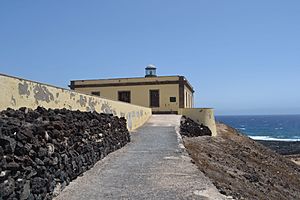Punta Martiño Lighthouse facts for kids
The Punta Martiño Lighthouse (which means Faro de Punta Martiño in Spanish) is an active lighthouse located on Lobos Island. This island is part of the Canary Islands and is very close to Fuerteventura, within the area of La Oliva.
This lighthouse stands on a hill at the north-eastern tip of Lobos Island. It works with other lighthouses, like the Pechiguera and Tostón lights. Together, they help guide ships through the La Bocayna strait, which is the water channel between Lanzarote and Fuerteventura.
| Location | Lobos Island Fuerteventura Canary Islands Spain |
|---|---|
| Coordinates | 28°45′54″N 13°48′54″W / 28.764957°N 13.814879°W |
| Year first constructed | 1865 |
| Construction | stone tower |
| Tower shape | cylindrical tower with balcony and lantern |
| Markings / pattern | unpainted tower, grey lantern |
| Height | 6 metres (20 ft) |
| Focal height | 29 metres (95 ft) |
| Range | 14 nautical miles (26 km; 16 mi) |
| Characteristic | Fl (2) W 15s. |
| Spain number | ES-12140 |
Contents
How the Lighthouse Was Built
The Punta Martiño Lighthouse first opened in 1865. This makes it one of the oldest lighthouses in the Canary Islands! It was built in a style common for lighthouses in the Canary Islands during the 1800s.
The lighthouse has a single-story house that was once painted. Dark volcanic rock was used to make special details in the stone work. A six-meter-high (about 20 feet) stone tower is attached to the side of the house that faces the sea.
How the Light Changed Over Time
The light inside the lighthouse has changed a lot over the years.
- Early Days: When it first started, the light was powered by olive oil. It shone a steady red light that could be seen from about 9 miles away.
- New Fuels: In 1883, the olive oil lamp was replaced with one that used paraffin, a type of fuel. Then, in 1923, an acetylene lamp took its place. This new lamp could shine much farther and flashed twice every five seconds.
- Automatic Light: An automatic sun valve was also added. This clever device meant that the lighthouse keeper no longer had to turn the light on at sunset and off at sunrise every day. The valve did it automatically!
- Modern Power: Today, the lighthouse uses solar panels and batteries for its power. It has a 150-watt electric halogen lamp. This powerful light can reach about 14 nautical miles, which is about 26 kilometers or 16 miles.
Life at the Lighthouse
In the 1960s, the Punta Martiño Lighthouse became "automated." This means machines took over the job of keeping the light working. Because of this, the lighthouse keeper and his family, who were the last people living on the island, moved away. Now, Lobos Island does not have any permanent residents.
You can visit the area around the lighthouse by walking on a marked path. It's about a 3.5-kilometer (2.2-mile) walk from where the ferry drops you off. While you can explore the lighthouse grounds, the tower and the buildings themselves are closed to visitors.
See also
- List of lighthouses in Spain
- List of lighthouses in the Canary Islands
 In Spanish: Faro de Punta Martiño para niños
In Spanish: Faro de Punta Martiño para niños


